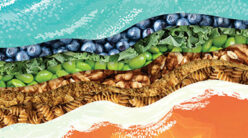Being married to the head of food safety and sanitation at our local health department has its perks. For one thing, Greg knows which restaurants to avoid while they clean up their act after a less-than-stellar inspection. Also, his decades of experience in public health have given him a wealth of entertaining stories to recount at dinner parties—despite the fact that many of his tales involve pest infestations, food adulteration, sewage backups, and other topics typically shunned at mealtime.
On the other hand, I’ve had to adjust to a few quirks. We were still on our honeymoon when I learned that if Greg said, “Let’s try somewhere else,” after glancing around an eatery, there was probably a good reason. When we do eat out, he’s the one wiping down the booster seat and reminding everyone to wash their hands after handling the menus—two items commonly missed in restaurants’ daily cleaning.
I’ve always prided myself on keeping a sparkling-clean home, but even I had to take my food safety practices up a notch when I began sharing a kitchen with a bona fide health inspector. While I knew the basics about avoiding food poisoning (or foodborne illness, to use Greg’s more accurate term), my husband has shared surprising facts and practical tips that help keep our family healthy. Here are a few of the highlights that might help you too:
Produce causes 46% of foodborne illnesses
Since I’m a vegetarian and don’t cook with eggs or dairy, I thought I didn’t have to worry much about food poisoning. My cutting boards are never contaminated with raw meat, and I can gleefully lick the cake batter bowl with no fear of salmonella from raw eggs.
But in light of recent recalls of flour tainted with salmonella and E. coli, my vegan cake batter isn’t safe for licking after all! Dangerous bacteria and viruses have been found in all sorts of plant foods: lettuce, peanut butter, melons, tofu, alfalfa sprouts, and asparagus, to name a few. One of the worst cases occurred in 2003, when 565 people contracted hepatitis A from green onions served at a restaurant in Pennsylvania. Three of the victims died.
Of course, that doesn’t mean you should avoid eating nutritious vegetables for fear of food poisoning. To lower your risk, thoroughly rinse or scrub produce in running water before eating, and remove any damaged or bruised spots.
Choosing a plant-based diet does help protect you from the most serious foodborne illnesses. Animal products are more likely to be contaminated, and they cause far more fatalities. Eating home-cooked meals is another way to minimize your exposure. In one study, 75 percent of illness outbreaks were linked to restaurants or catered events.
Never eat food that has been sitting out at room temperature for more than four hours
I’m sure you’ve faced a scenario like this: After a potluck with friends, you get absorbed in conversation and forget all about your dish on the kitchen island. When you finally pack up to go home, you stare at those last two pieces of your homemade lasagna. They would be perfect for lunch tomorrow . . . but are they still safe to eat?
If it’s been more than four hours since you took the pan out of the oven, don’t risk it. Once food enters the “danger zone,” between 40°F and 140°F, bacteria can multiply rapidly. Worse yet, some types of bacteria produce toxins that can’t be easily destroyed by reheating the food.
“Avoid the danger zone like the plague,” Greg advises. Keep hot food hot and cold food cold, and move any food that could spoil to the refrigerator within two hours to give it time to chill to a safe temperature. Don’t thaw frozen food on the counter, since bacteria can begin to grow as the food slowly warms up.
One of Greg’s danger zone horror stories involves a graduation party where the host left a turkey to thaw overnight on top of a freezer, and left partially cooked chicken to cool on the countertop overnight before fully cooking it the next morning. The result was several hundred sick people.
To make sure food stays safe in the fridge or freezer, have a refrigerator thermometer, and check it periodically. Your refrigerator should be at 40°F or lower, and your freezer at 0°F.
Cool food quickly to prevent bacteria from growing
Popping your food into the fridge or freezer doesn’t instantly take it out of the danger zone. Greg recalls a church’s fundraising dinner fiasco. The day before the event, church members cooked up a huge batch of chili and put it in the refrigerator to cool. When Greg arrived the next morning to inspect their food-service setup, he plunged his thermometer deep into the vat of chili. In the center, the chili was still at 70 degrees!
To avoid a similar mistake, follow Greg’s tips for cooling food quickly:
Use a shallow container rather than a deep bowl. More surface area allows heat to escape.
Divide the food up into several small portions.
Leave the lid off or slightly ajar to allow heat to escape.
To cool a large amount of food quickly, use an ice bath. Fill your sink with a mix of water and ice. Set the container of food in the ice water, and stir the food every 10 to 15 minutes. It should be cool enough to refrigerate in less than an hour.
Discard leftovers that are more than seven days old
I can’t stand to throw food away, so before I got married, my approach to leftovers was simple: If it didn’t smell bad and didn’t have mold growing on it, I ate it. Greg was far more discriminating. “How long has that been in the refrigerator?” he’d ask suspiciously when I trotted out a bowl of last week’s spaghetti.
His biggest concern was listeria, a deadly bacteria that can grow even in the cold temperatures of the fridge. Like many foodborne pathogens, you can’t see, smell, or taste it, so my method of determining food safety was clearly inadequate.
After a couple years of marriage, I grew tired of racking my brain to remember whether I’d made spaghetti last Wednesday or Thursday . . . or was it Monday? Now I label leftovers with the day of the week. (I use masking tape because it’s handy and doesn’t leave a sticky residue.) If we can’t eat up a batch of food within seven days, I stick a portion of it in the freezer.
Greg’s seven-day guideline works for most cooked plant foods and cut up raw produce. Some animal products—especially raw poultry, seafood, and ground meat—need to be used within a couple of days, while other foods can be stored much longer. For instance, products with a high acid content, such as lemon juice, salad dressing, or ketchup, will keep for months.
Norovirus can survive in your bathroom or kitchen for weeks
The term “stomach flu” never arises in our household when someone falls ill with an intestinal ailment. Instead, Greg blames norovirus, the most common foodborne bug, which causes short-lived but miserable bouts of vomiting and diarrhea.
These hardy germs aren’t fazed by hand sanitizer and many household cleaners, and they don’t mind waiting days or weeks for a new human host to pick them up. Virus-laden droplets from a single vomiting episode can fly through the air, contaminating everything within a twenty-five-foot radius. If you’re in the blast zone, you have a 50 to 70 percent chance of getting sick.
Now picture an ill farmworker or food-service employee who doesn’t wash their hands adequately and then handles piles of leafy greens, and you can see why norovirus causes more than half of food poisoning cases.
In 2006, Greg was part of the investigation team for a major norovirus outbreak at a chain restaurant. A line cook vomited in the kitchen, and the manager cleaned the area with the wrong sanitizer, spreading the virus throughout the kitchen instead of killing it. Within days, 364 customers and 20 employees had fallen ill.
Washing your hands vigilantly and cleaning fresh fruits and vegetables before eating them can reduce your risk of becoming one of the approximately 20 million people in the U.S. who get this bug each year. If you or someone in your family does come down with norovirus, take these steps to avoid spreading it to others:
Stay away from work, school, and other public places until you’ve been symptom-free for at least 24 hours.
Avoid making food for others during the same time period—even if (no, make that especially if) you promised to make a giant salad for cousin Yvonne’s baby shower. You don’t want that event to go down in family history as “the time everyone got sick.”
Disinfect hard surfaces, such as bathroom fixtures, with a solution of ½ cup of chlorine bleach in 1 gallon of water. Let the solution stand for 10 minutes before rinsing it off with water. Wash soiled fabrics with hot water and laundry detergent (add bleach to color-safe loads), and dry on the highest heat setting. Carpets and upholstery can be steam cleaned.
Small Tweaks Pay Off
By now you might think that sharing a kitchen with a health inspector is a grim experience, fraught with tales of danger lurking in the refrigerator, the produce aisle, and the restaurant kitchen. However, Greg manages to keep a sense of humor about food safety. We still eat out and have dinner at friends’ homes, although there are times when he quips, “We’d better say an extra prayer over this meal.”
Greg’s goal, whether at home or at work, is to keep people safe by educating them about ways to prevent foodborne illnesses. Now that you know some of his insider tips, you’ll be better equipped to spare your family and friends from spending unnecessary hours getting acquainted with the toilet. As for myself, since I started implementing Greg’s best practices for safe food handling, I rarely have even a stomachache!
Rachel Cabose is a part-time author and full-time mom living in Charlotte, Michigan. Her husband, Greg, is a registered environmental health sanitarian with more than thirty years of experience. He works as the community services supervisor at Barry-Eaton District Health Department.






